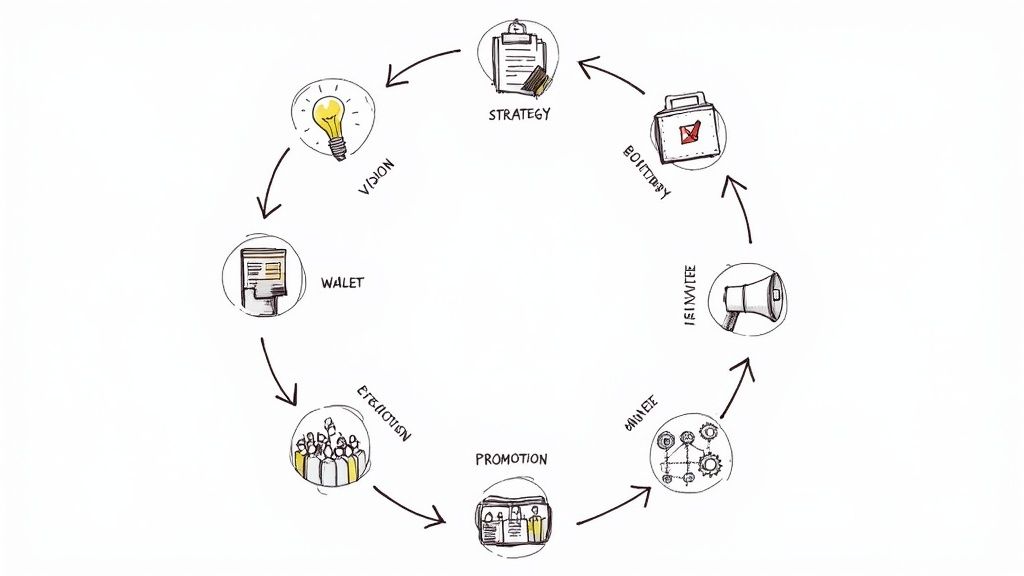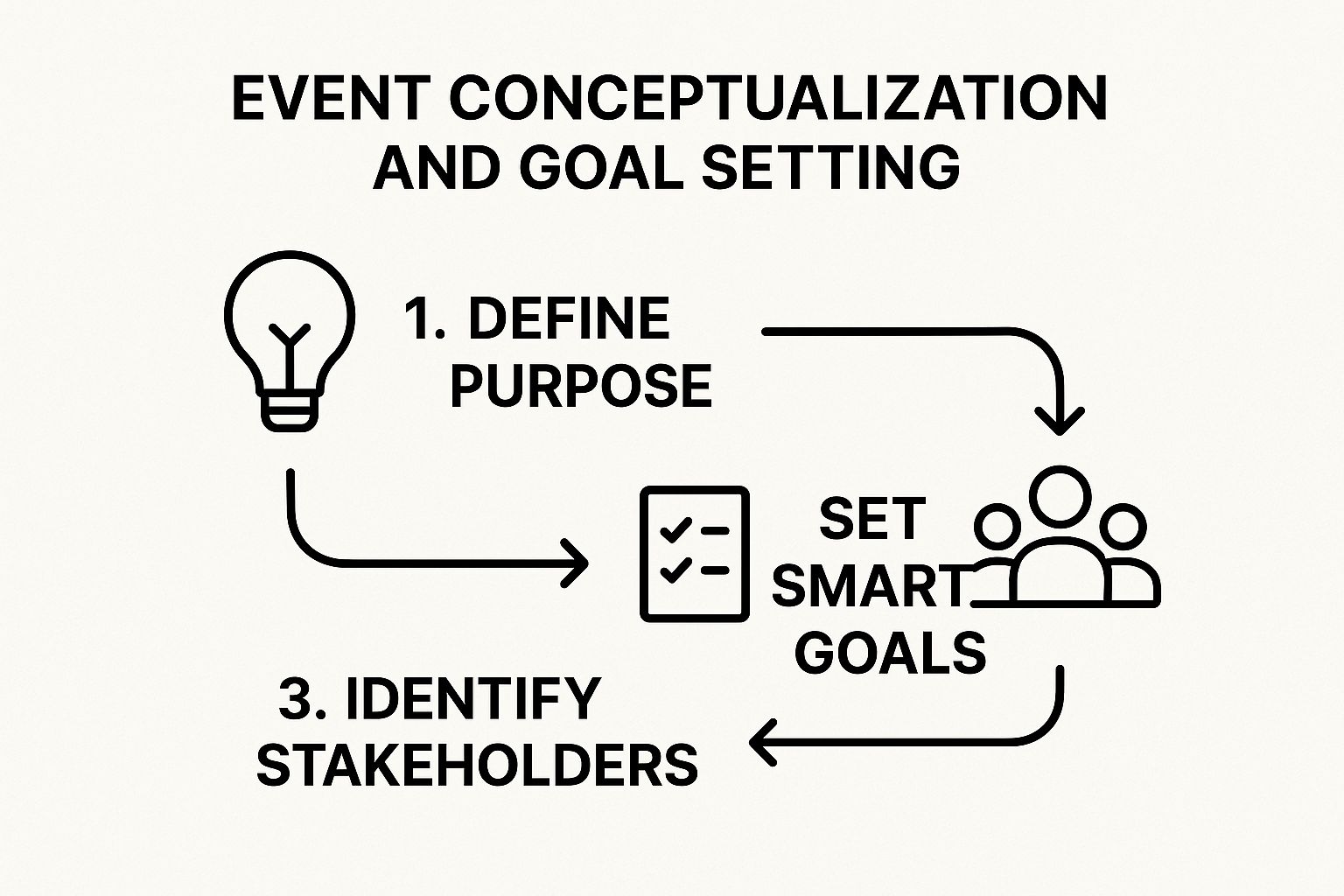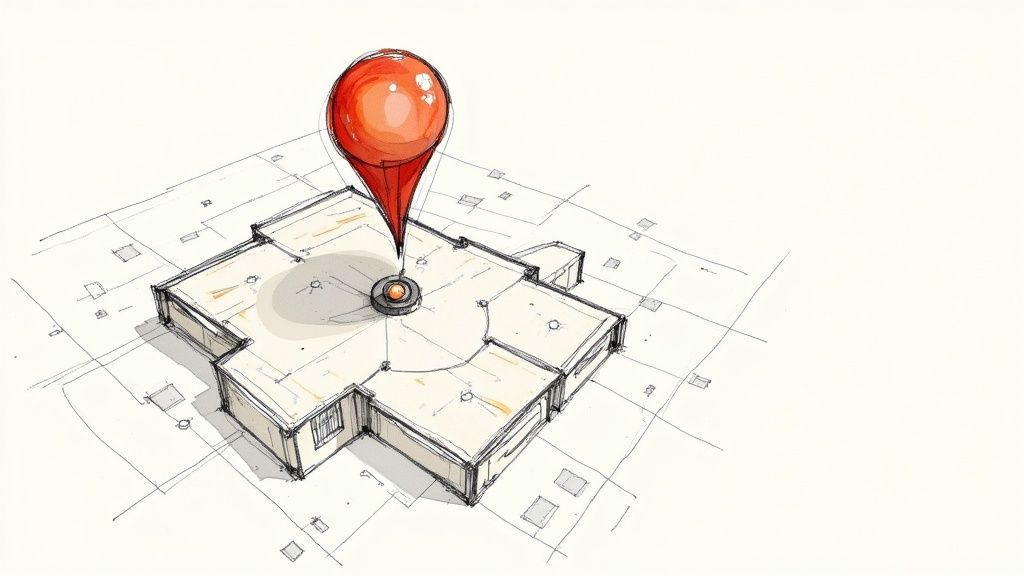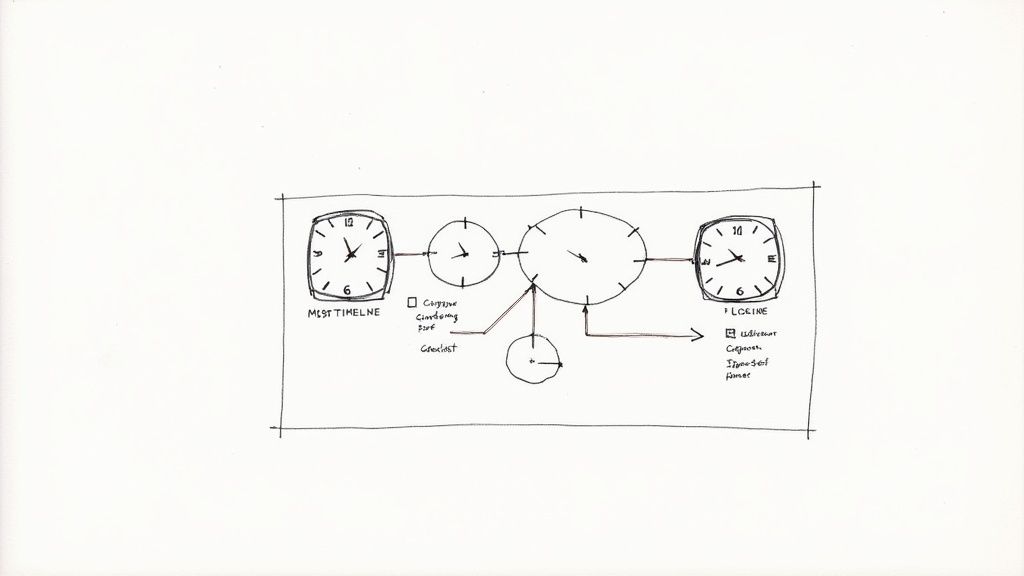July 17, 2025

Planning a successful event can feel like conducting an orchestra, every instrument must play its part in perfect harmony. Whether you're organizing a corporate conference for a professional association, a non-profit gala, or a vibrant community festival, a structured approach is the key to transforming a great idea into an unforgettable experience. Overlooking a single step in the process can lead to critical budget overruns, logistical nightmares, and a lackluster attendee experience that fails to deliver on its promise.
This comprehensive guide breaks down the entire process into 8 distinct stages in event planning. We will provide a strategic roadmap that moves sequentially from initial concept to post-event analysis. Think of this as your master blueprint for flawless execution, packed with actionable insights, expert tips, and real-world examples to guide you.
For each stage, we will outline the critical tasks and decisions required for success. You will learn not only what to do, but how to do it efficiently. We'll also highlight how leveraging an all-in-one platform like GroupOS can streamline each phase, helping you automate tedious tasks and focus on creating impactful, engaging events. Following these structured stages will help you mitigate risks, maximize your resources, and deliver an experience that resonates with your audience long after the doors close. Let’s dive into the first stage.
Every successful event, from a global tech conference to an intimate charity gala, begins not with booking a venue, but with a foundational question: Why? This initial phase, Event Conceptualization and Goal Setting, is arguably the most critical of all stages in event planning. It's where you define the core purpose, establish a clear vision, and set the strategic direction that will inform every subsequent decision. Skipping or rushing this stage is like building a house without a blueprint; the final structure will lack integrity and purpose.
The primary objective here is to move from a vague idea to a concrete, documented plan. This involves identifying the event's "big why," determining the target audience, and creating the overarching concept or theme that will deliver a specific experience. Think of Apple's product launches, where the core purpose is to generate global buzz and drive immediate sales, a goal that dictates their secretive, high-production-value approach. Similarly, TED's entire event model is built around the purpose of "ideas worth spreading," which guides their speaker selection, format, and branding.
To build a strong foundation, your process must be systematic. It starts with defining the event's purpose, then translates that purpose into measurable objectives, and finally identifies the key people who need to be involved. This structured approach ensures alignment and clarity from the very beginning.
This process flow visualizes the core steps for establishing a solid event foundation.

This sequence ensures that your objectives are directly tied to your core purpose and that the right stakeholders are engaged to validate and support them.
Once the event's "why" is established, the next immediate question is: How much? This brings us to Budget Planning and Financial Management, a crucial stage that transforms your strategic vision into a financially viable reality. This phase is about more than just numbers on a spreadsheet; it's the economic engine that powers every decision, from venue selection to marketing spend. A poorly managed budget is the fastest way to derail an otherwise brilliant event concept.
The core objective here is to create a comprehensive financial roadmap. This involves meticulously estimating all potential expenses, identifying and securing funding sources, and implementing robust systems to track every dollar spent. Consider the massive logistical and financial undertaking of a festival like Coachella, which manages a budget exceeding $100 million. Every line item, from artist fees to security staffing, is rigorously planned and controlled to ensure profitability. Likewise, a corporate conference must use detailed financial models to align expenses with projected ticket sales and sponsorship revenue.
Building a resilient event budget requires a structured approach that moves from broad estimates to granular control. This process begins with a detailed estimation of all costs, followed by the strategic allocation of funds to different categories, and is supported by continuous tracking and financial controls to prevent overspending. This methodical flow ensures you maintain financial health throughout the event lifecycle.
A well-defined budget serves as both a planning tool and a performance metric, holding the event accountable to its financial goals. It provides the clarity needed to make tough decisions, such as choosing between two vendors or reallocating funds when unforeseen costs arise.
Once your event’s goals are set and the budget is framed, the next critical step in the stages of event planning is finding the right home for your event. Venue Research and Selection is far more than just booking a space; it's a strategic decision that directly impacts attendee experience, logistical feasibility, and your bottom line. The physical environment sets the tone, dictates the flow of movement, and can either enhance or hinder your program's success. An unsuitable venue can create insurmountable obstacles, while the perfect one acts as a silent partner, amplifying your event's message.

The goal of this phase is to find a location that aligns perfectly with your event's specific needs, from capacity and technical infrastructure to brand identity and budget. Consider how Google I/O leverages the sprawling, tech-ready Moscone Center to accommodate thousands of developers and complex demonstrations. In contrast, the World Economic Forum chooses the exclusive, secluded mountain setting of Davos to foster high-level, private networking. The venue becomes an integral part of the event's identity and function.
To secure the ideal venue, you need a methodical approach that moves from a broad search to a signed contract. This process involves thorough research to identify potential locations, in-person evaluations to assess suitability, and careful negotiation to secure favorable terms. This ensures the chosen venue is not just available, but is the absolute best fit for your objectives.
This structured workflow prevents common pitfalls like overlooking hidden costs, misjudging capacity, or being locked into inflexible contracts. It’s a crucial due diligence process that safeguards your event's success.
No event is an island; its success relies on a network of specialized external partners. This brings us to a pivotal stage in event planning: Vendor Selection and Management. This phase is the systematic process of identifying, vetting, contracting, and coordinating with the myriad of suppliers, from caterers and audio-visual technicians to security firms and transportation services. An event’s quality is a direct reflection of its vendors, making this stage a critical determinant of the final attendee experience.
The core objective here is to assemble a reliable, high-performing team of external experts who can execute your vision flawlessly and within budget. It's about transforming your event blueprint into a tangible reality through strategic partnerships. Think of the Olympic Games, where organizers must coordinate hundreds of vendors to manage everything from global logistics to on-site catering. Similarly, a corporate conference relies on a preferred vendor list to ensure consistent quality and pricing, demonstrating the importance of a structured sourcing and management process.
To build a robust support system for your event, your vendor management must be methodical. The process begins with clearly defining your needs, moves into a rigorous evaluation and selection phase, and culminates in a clear, legally sound agreement. This ensures that every partner is aligned with your event’s goals and standards. A poorly vetted vendor can jeopardize your budget, timeline, and reputation.
This disciplined approach protects you from potential pitfalls and sets the foundation for a successful partnership. It ensures that expectations are clearly defined and agreed upon before any work begins, preventing misunderstandings down the line.
Even the most meticulously planned event will fail if no one knows it's happening. The Marketing and Promotion Strategy stage is where you build bridges between your event concept and your target audience. This comprehensive phase involves developing and executing promotional campaigns designed to generate awareness, drive registrations, and engage attendees before, during, and after the event. It's the engine that transforms a well-laid plan into a well-attended reality, making it a pivotal component in the stages of event planning.
The core objective is to create a multi-channel narrative that resonates with your specific audience. This goes beyond simply sending an email blast; it’s about crafting a consistent brand message and deploying it across the right platforms to build excitement and urgency. Think of SXSW's masterful blend of influencer partnerships, exclusive content drops, and social media buzz, which creates a powerful sense of FOMO (fear of missing out) months in advance. Similarly, Salesforce's Dreamforce leverages its passionate community, turning attendees and speakers into powerful brand ambassadors.

A successful marketing strategy requires a systematic blueprint that outlines which channels you will use, what content you will share, and the timeline for your campaign. This ensures your message is consistent and delivered at the optimal time to maximize impact. The goal is to create a journey that guides a potential attendee from initial awareness to final registration and active participation.
This process involves a strategic selection of marketing channels based on where your audience spends their time, whether it's LinkedIn for a corporate webinar series or Instagram for a lifestyle festival. From there, you develop a content calendar that specifies the creation of blog posts, videos, social media updates, and email newsletters, all timed to build momentum leading up to the event.
If the conceptualization stage is the event's "why," then Logistics and Operations Planning is the "how." This is where the grand vision is meticulously translated into a sequence of coordinated actions. This stage covers every tangible, moving part of the event, from managing attendee registration and coordinating transportation to scheduling catering services and planning for every conceivable contingency. It's the operational backbone that ensures the entire event runs smoothly, efficiently, and without a hitch.
The core objective here is to transform strategy into a detailed, executable plan. This is the stage where you leave nothing to chance. Consider the intricate logistics behind a Formula 1 race, where entire teams, cars, and broadcast equipment are moved between international venues in a matter of days. Likewise, music festivals are masterpieces of operational planning, coordinating artist schedules, stage transitions, and crowd safety for tens of thousands of people. These examples highlight how robust logistics are essential to creating a seamless experience, a key component in any of the stages in event planning.

To master event operations, you need a systematic approach that breaks down the complexity into manageable components. This involves creating a master timeline, allocating resources effectively, and, most importantly, preparing for the unexpected. A well-defined operational blueprint is your defense against chaos and your guarantee of a professional execution.
This process involves detailing every single task, from the macro (venue setup) to the micro (placement of signage). Each element requires a clear owner, a deadline, and a dependency, ensuring everyone knows their role and how it impacts the overall event flow. By focusing on this detailed blueprint, you can proactively manage the countless moving parts of your event. For a deeper dive into this area, explore our comprehensive guide on event management planning.
After months of meticulous preparation, the day arrives. This is where all the planning, strategy, and coordination culminate. The Event Execution and On-Site Management stage is the live performance of your event, a real-time process of bringing the blueprint to life. It's the moment when your team transitions from planners to directors, orchestrating every moving part to create a seamless and impactful experience for attendees. This phase is less about strategy and more about operational excellence, adaptability, and leadership under pressure.
The core objective during this stage is to flawlessly manage all logistical and experiential elements as they unfold. This involves overseeing venue setup, directing staff and volunteers, troubleshooting technical glitches, and ensuring the event timeline is strictly followed. Think of the production crew for the Olympic Games opening ceremony, who manage thousands of performers, complex technical cues, and a live global broadcast simultaneously. Their success hinges on precise, moment-to-moment management, a hallmark of this critical phase in the event planning lifecycle.
To ensure a smooth execution, you must establish a clear operational framework. This involves setting up a central point of contact for all decision-making, ensuring constant communication among team leads, and actively monitoring every aspect of the event from attendee flow to speaker readiness. This proactive management prevents small issues from escalating into major problems.
This structured approach to on-site management ensures that your team can respond to challenges swiftly and effectively, maintaining the integrity and quality of the attendee experience from start to finish.
The end of the event is not the end of the work; in many ways, it's the beginning of the next cycle of improvement. This final stage in event planning, Post-Event Evaluation and Follow-up, is where you close the loop by measuring success against the goals you set in the very first stage. It’s the systematic process of gathering data, analyzing performance, and documenting key learnings to justify investment, demonstrate value, and ensure future events are even more successful. Neglecting this phase means leaving valuable data on the table and repeating the same mistakes.
The main objective here is to transform raw data and anecdotal feedback into actionable intelligence. This involves a comprehensive review of everything from attendee satisfaction and budget performance to vendor reliability and team efficiency. For example, corporate training events go beyond simple attendance numbers, measuring post-event learning outcomes and behavior change to calculate true ROI. Similarly, non-profits analyze fundraising data to determine the cost-per-dollar-raised and identify key drivers of donor retention.
To build a comprehensive picture of event performance, you must move systematically from collecting data to analyzing it and finally, reporting the findings to key stakeholders. This structured approach ensures that your conclusions are evidence-based and that the lessons learned are formally documented and shared. It validates the event's impact and provides a clear roadmap for future initiatives.
A well-executed evaluation provides concrete proof of your event's success and is a crucial part of the overall event planning lifecycle. It answers the critical question: "Did we achieve what we set out to do?"
Navigating the intricate landscape of event management can often feel like conducting a symphony. Each instrument, from the quiet piccolo of initial brainstorming to the resounding brass of on-site execution, must play its part in perfect harmony. We've journeyed through the eight critical stages in event planning, revealing how a structured, methodical approach can transform potential chaos into a masterpiece of organization and engagement. Viewing this process not as a series of disconnected tasks but as an interconnected lifecycle is the fundamental shift that separates good events from truly unforgettable ones.
The framework we've explored, starting with Event Conceptualization and Goal Setting, lays the non-negotiable foundation. Without a clear "why," the "what" and "how" that follow will lack direction and impact. This clarity directly informs your Budget Planning, ensuring every dollar is allocated with purpose, and guides your search during Venue and Vendor Selection, guaranteeing your partners align with your event’s core objectives. Each subsequent stage builds directly upon the last, creating a powerful momentum.
Mastering these stages requires a blend of strategic foresight and meticulous execution. The most successful event professionals understand that success is not accidental; it is designed. Here are the core principles to carry forward into your next project:
The true value of understanding these stages in event planning lies in their application. It's about moving from theoretical knowledge to practical mastery. As you prepare for your next event, commit to implementing a more structured approach. Start by creating a comprehensive project plan that maps out each of the eight stages, complete with timelines, key stakeholders, and defined success metrics for each phase.
Embrace technology not as a mere convenience but as a strategic asset. A centralized platform can eliminate the friction caused by juggling disparate spreadsheets, email chains, and ticketing systems. This consolidation frees up your most valuable resource: your time. It allows you to shift your focus from administrative busywork to the high-impact activities that create real value for your attendees, sponsors, and community members. By adopting this disciplined, integrated, and data-informed methodology, you are no longer just managing an event; you are orchestrating a predictable, scalable, and resonant success story.
Ready to transform your event planning from a complex puzzle into a streamlined, powerful workflow? See how GroupOS unifies ticketing, communication, and analytics into a single command center, empowering you to master every stage of the event lifecycle. Explore GroupOS today to build and grow your community with confidence.


